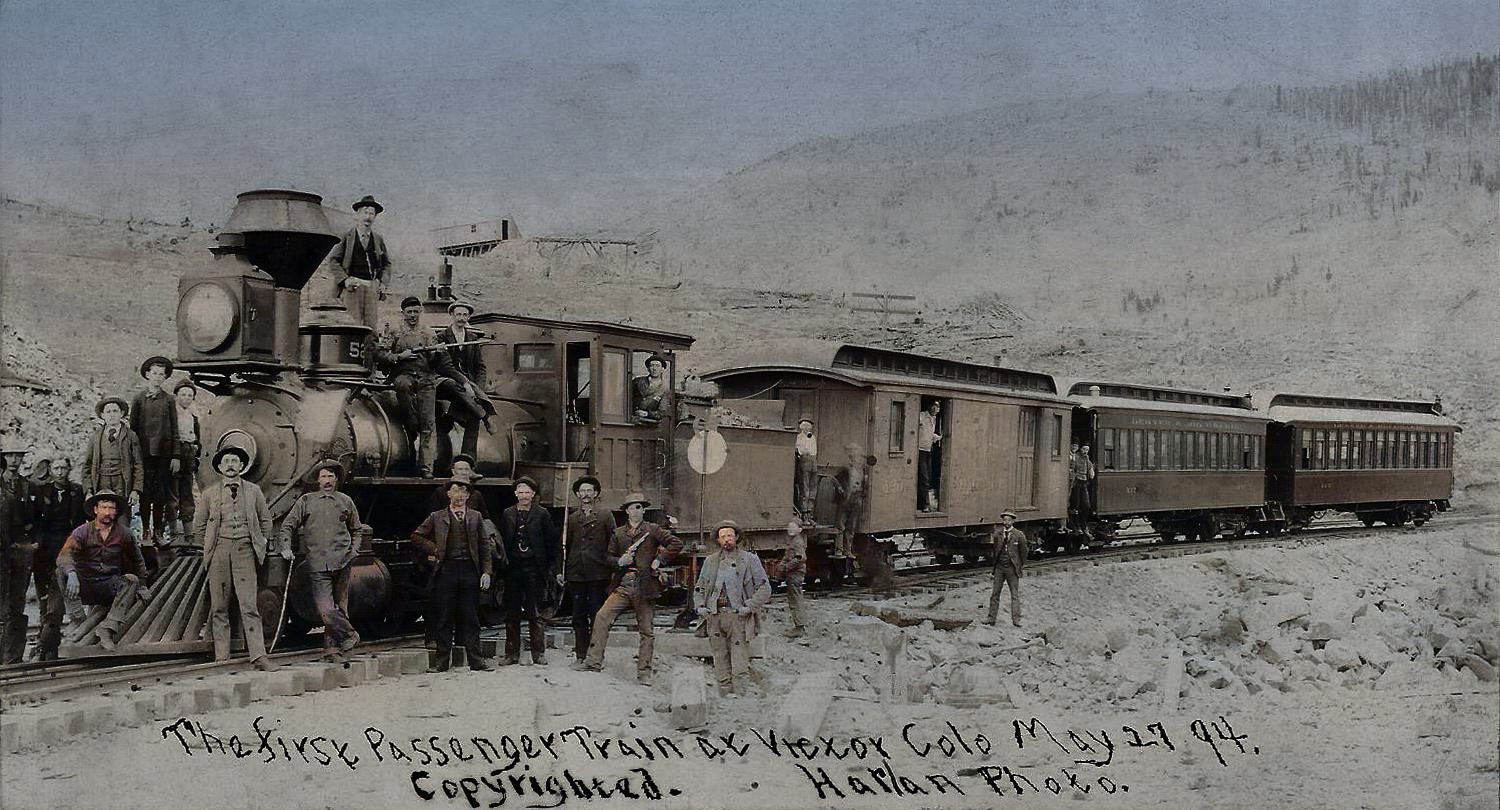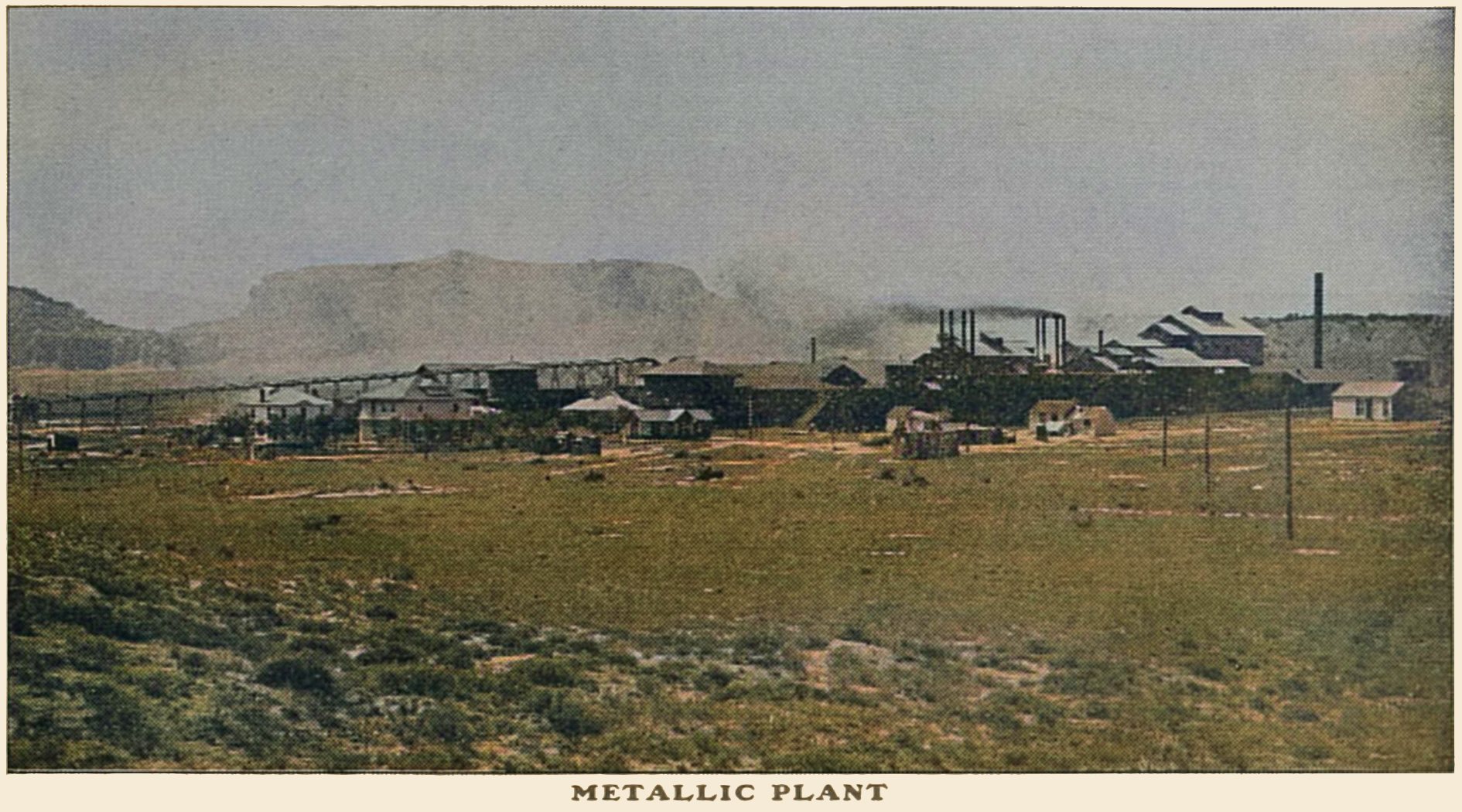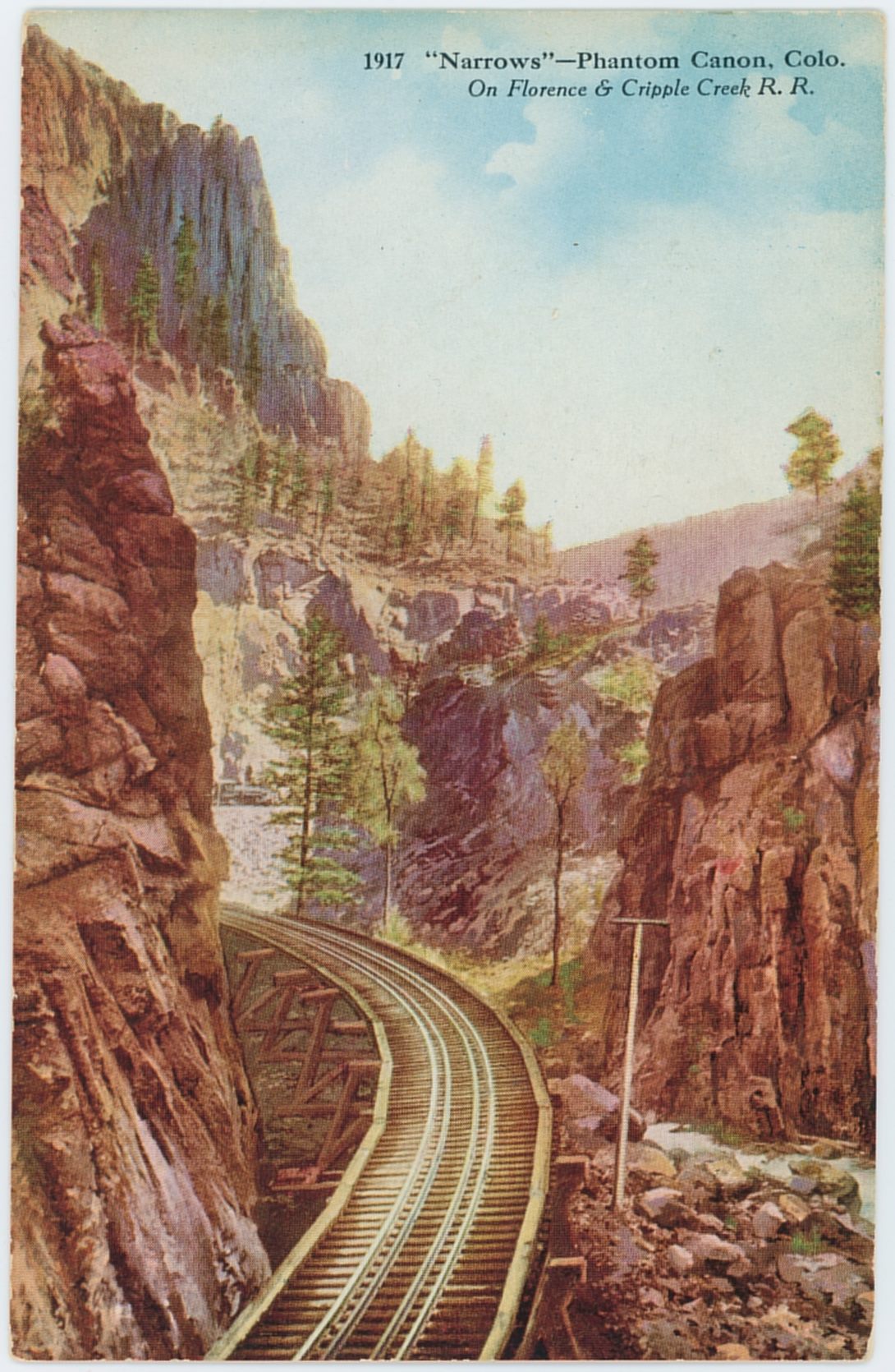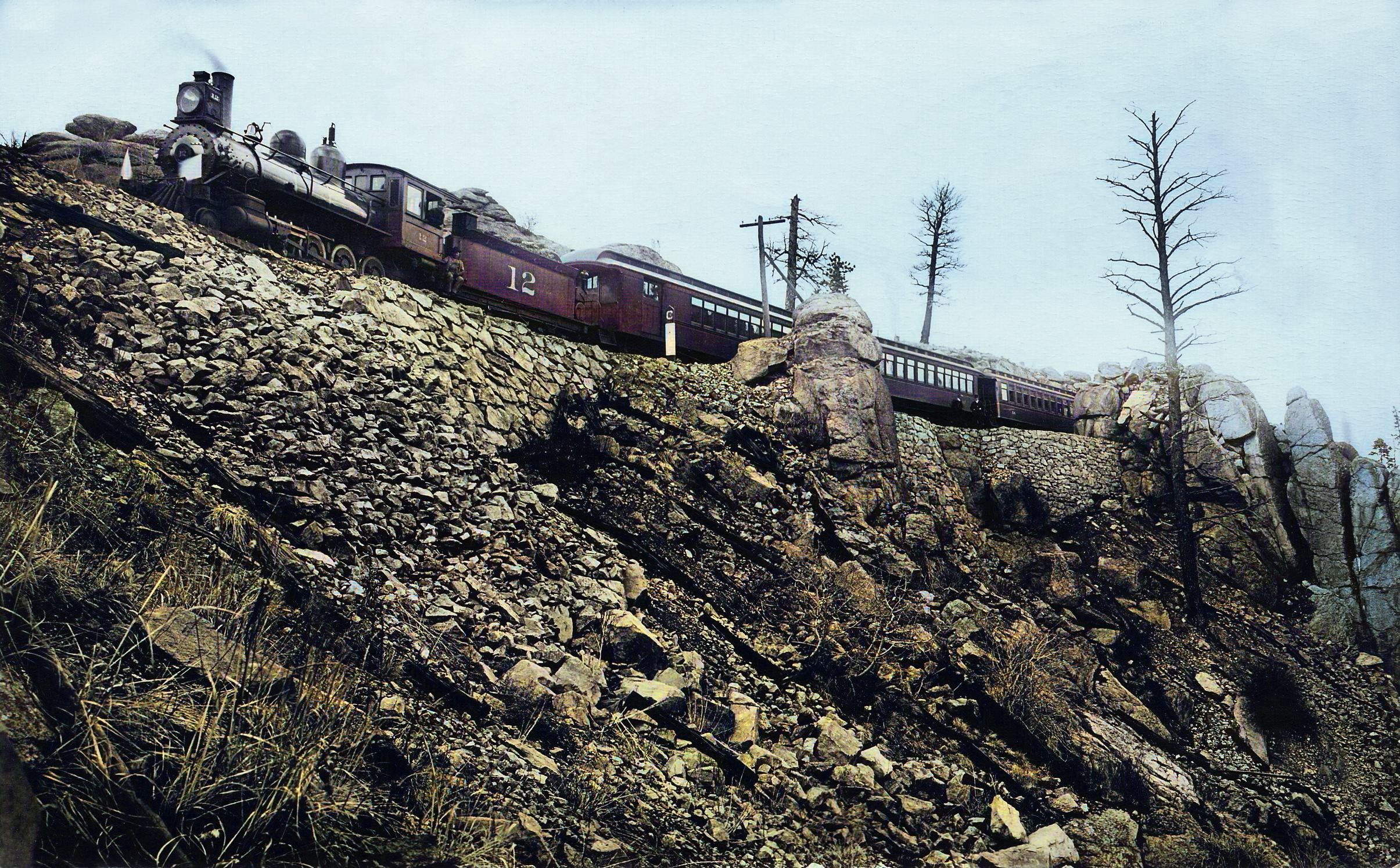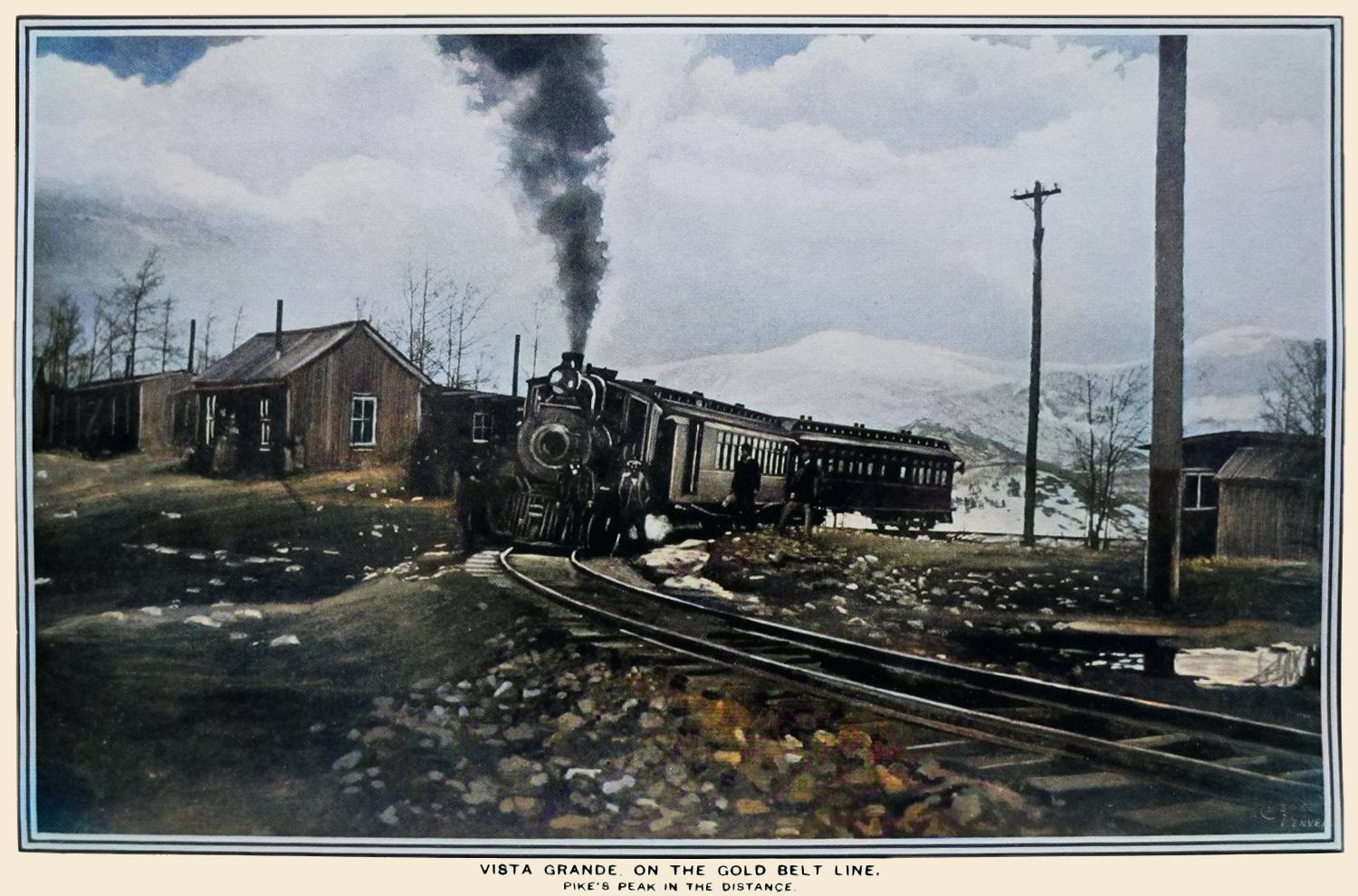-> My Collection, Also found at the Internet Archive Site. Link to first page of article.
New Year Edition 1903
(page 37-38)
I added images from my collection, and procured the coloring of the images, source article had one none related pic used.
 |
The first line to enter the great mining district, and it has been a powerful factor in the development of the wonderfully rich mines. |  |
When Cripple Creek was discovered, in 1891, and development began to disclose the magnitude of its importance in 1892, the problem was how to get the ore down to the smelters at Pueblo and Denver.
The Florence & Cripple Creek railroad was the solution of that problem.
The Denver & Rio Grande Grande railroad follows the Arkansas from Pueblo westward. To make an outlet for the camp and give it extensive railroad connections, it was, therefore, only necessary to build a line connecting it with the Denver & Rio Grande system on the Arkansas.
But this was a great undertaking, for the camp is a mile higher than the river, and one of the roughest and most broken mountain countries on earth intervening.
But the thing was done, and the Florence & Cripple Creek entered the camp in July, 1894.
A few miles south of the camp there heads a little stream called Eight-Mile. It is often only a dry gorge, and often again a raging, resistless torrent that would sweep the Pyramids before it with a whiff.
It traverses this abysmal geological rift, called Eight-Mile canon, so deep and crooked that it would make an eagle dizzy to look down into it.
The difficulties that were overcome to get the road up through that deep, narrow gorge, springing from wall to wall and clinging with tooth and nail to its often perpendicular sides, and keeping out of the way of torrential floods - all that would make a book - but the book wouldn't interest anybody but civil engineers, and, since the job is finished, we don't care to interest them.
The road is frequently called the beautiful Florence line, and that the name is appropriate may be well understood from even the following short and inadequate description:
"We enter the neat and pleasant little train at the Florence union station, where the platforms are always crowded with passengers and their baggage, en route to the camp.
"We have forty miles to go onward and one mile to go upward to reach our destination.
"We move out of the town through orchards bending with fruit—or perhaps only aflame with fragrant blossoms, as the season happens.
"We cross the Arkansas on a level rail, and then we strike the upward grade.
"We pass Cyanide, the station of the great chemical extraction plant, where the side tracks are filled with miles of ore cars.
"We go on over the rolling prairie, up toward the foot-hills, up toward the abysmal Eight-Mile canon, that we must traverse through all its deep and narrow sinuosities, as we push onward and upward.
"Now we are entering the foothills. The scenery is becoming enchanting - enchanting is the word, the only word. These grassy glades of the foothills - little flower-starred prairie parks, fringed and dotted with pinon trees and walled about by high ridges of rocks - furnish the most really enchanting scenes in Colorado all along the mountains.
They are lovely, pensive, delightful little natural parks.
"These little sheltered spots, caressed by the sun and favored by the showers, are the home of the wild flowers and beloved of old by the game - when game there was, but now fled in terror from the steam whistle (all but the saucy, inquisitive prairie dogs), to remoter haunts.
"Here we are at Oro Junta (Gold Junction in English). —> Here connection is made with the Canon City & Cripple Creek railroad, an auxiliary of the Florence & Cripple Creek.
"We double up with the Canon City train and put their engine ahead of ours, and the two buckle down to their task and we glide onward, through glade after glade, toward the Eight-Mile and the mouth of the narrow, abysmal canon.
"On we speed and - yes, here we are in the bare, grassless gravel, the torrential wash of the Eight-Mile, belched out of the canon's raging month when the wild little stream was on the rampage, and carried down the glade a mile from the usual bed of the current, by the gathered impulse of rage, through long and steep miles of confinement, between so deep and narrow walls, when betimes the laden clouds burst and drop their watery burden among the mountain peaks around its head - as summer clouds are wont to do when they drift upon mountain peaks.
"Some electrical secret in this sudden bursting of rain clouds amidst mountain peaks, and connected with the long history of mountain sculpture and canon making - such resistless force! The gouging out of heavy rock-work, its merest pastime - and thus the canon is formed through some original rift, and thus the forming of it goes on from century to century.
"But here we are! This is it! This is the mouth of the canon! No time for talking, now; only for looking with all our eyes and gasping out our amazement in briefest exclamatory vocables.
"There is a little tunnel. We are through it in a jiffy and out on the other side - and the other side is still worse, for we are not only down in the depths, but up on a trestle. They call this side Rocky Point, but that name doesn't distinguish it from a hundred other points, for the whole business is rocks all the way up - rocks, rocks; nothing but rocks - oh, yes, and a few trees, as the pictures show - and wild flowers!
Just look! - in every smallest crevice in those towering walls, a flower seed has been planted by the wind, and the dust has covered it and the mists have watered it. and now it is flaunting its luxuriance of beautiful bloom up there where only the eagles can reach it.
"Look at that deep crack in the rocks ahead! They call it The Narrows. Why, a sunbeam is too broad to get through there, but you can see the light beyond through it; and—oh, Heavens! they are actually going to try to drag the train through that crooked crack!—mercy, we'll all be crushed!
"Here we go, squeezing through another one of those deep, narrow, crooked cracks and now! - now, we are are out on Phantom Curve. Don't jump off here or you will be a haggard phantom yourself in the whisk of a lamb's tail - we're on a steel trestle and it's 100 feet straight down to that innocent-looking, treacherous brook that's only longing to swallow you if you step off.
"From here, on the climb is steep, steeper, steepest, but the canon widens out into a narrow valley and the rocks are lower and partly covered with soil and shrubbery - more picturesque than farther down, but not so gaspingly awful and menacing.
"But here we are at Alta Vista (High View), where we obtain our first glimpse of the great Cripple Creek gold mining district.
"With this panorama spread out before us, we wend our way on to Victor, thence around and up the north side of Big Bull hill, through Goldfield and Independence, to the summit of the Golden Circle Railroad, and the highest point in the Cripple Creek district, passing en route, near the summit, the town of Altman, the highest incorporated town on the face of the globe - in sight of all the Cripple Creek camp - in sight of most everything within a radius of a hundred miles - oh, such a sight!!!
The picture gives you only a faint conception of its matchless glories.
"The pretty station on the summit is called - and properly called - Vista Grande, which is straight Quackenbass Spanish for grand view, and you'll never see anything grander if you live a thousand years.
There are the golden hills of the Cripple Creek district in full view - Battle mountain, Squaw mountain, Bull hill, Raven hill, Gold hill, Beacon hill, Globe hill and Tenderfoot hill, all dotted over with bustling towns, and freckled with the dumps of mining pits - with all of these we are on a level.
But beyond these - ah, there it is! Pike's Peak! glorious in its grand repose, with the morning sun dashing itself into splinters on the crystalline snows that cover the summit - and looking so near, in its Titanic hugeness, through this limpid, flawless atmosphere, yet really twenty-five miles distant.
"And then to the westward - far and far away - eighty miles - across a rugged ocean of volcanic hills, the white sky-line of the main range, the Sangre de Cristo, lying against the mellow blue of the horizon - a serrated, limitless wall of glistening white, with scores of towering peaks blazing in the morning sunlight.
And below - away and away below - the valley of the Arkansas, ribboned with its green line of cottonwoods. And beyond this, southward still, the smaller range of the Sierra Mojada (Wet Mountain) and the Cuerna Verde (Green Horn) and the two cones of the Spanish Peaks, matchless in symmetrical grandeur as they stand out, hooded in crystalline snow - ah, such a scene, this well-named Vista Grande, such a deathless memory of Titanic grandeurs - and that name, Sangre de Cristo (Blood of Christ), what an insistent clutch it takes upon the imagination!"
The Florence & Cripple Creek was incorporated in 1893, by William E. Johnson, Eben Smith, D. H. Moffat, et al. It was opened to Cripple Creek in July, 1894. The company owns a narrow-gauge line from Florence to Cripple Creek.
The Golden Circle Railroad was incorporated by the owners of the Florence & Cripple Creek. This property comprises a circle railroad from Victor, passing through Goldfield, thence around Battle mountain to a point very near Altman, on Bull hill.
It was opened for traffic in 1896.
The Canon City & Cripple Creek Railroad runs from Canon City to Oro Junta, where it connects with the main line of the Florence & Cripple Creek. It was opened for traffic in March, 1900.
Both the Florence & Cripple Creek and Canon City & Cripple Creek railroads connect with the Denver & Rio Grande at Florence and Canon City.
